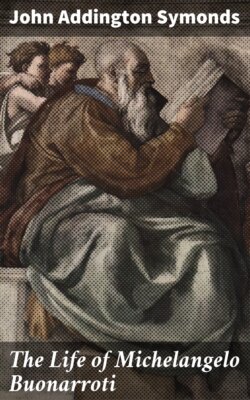Читать книгу The Life of Michelangelo Buonarroti - John Addington Symonds - Страница 13
На сайте Литреса книга снята с продажи.
I
ОглавлениеAfter the death of Lorenzo de' Medici, Michelangelo returned to his father's home, and began to work upon a statue of Hercules, which is now lost. It used to stand in the Strozzi Palace until the siege of Florence in 1530, when Giovanni Battista della Palla bought it from the steward of Filippo Strozzi, and sent it into France as a present to the king.
The Magnificent left seven children by his wife Clarice, of the princely Roman house of the Orsini. The eldest, Piero, was married to Alfonsina, of the same illustrious family. Giovanni, the second, had already received a cardinal's hat from his kinsman, Innocent VIII. Guiliano, the third, was destined to play a considerable part in Florentine history under the title of Duke of Nemours. One daughter was married to a Salviati, another to a Ridolfi, a third to the Pope's son, Franceschetto Cybò. The fourth, Luisa, had been betrothed to her distant cousin, Giovanni de' Medici; but the match was broken off, and she remained unmarried.
Piero now occupied that position of eminence and semi-despotic authority in Florence which his father and grandfather had held; but he was made of different stuff, both mentally and physically. The Orsini blood, which he inherited from his mother, mixed but ill in his veins with that of Florentine citizens and bankers. Following the proud and insolent traditions of his maternal ancestors, he began to discard the mask of civil urbanity with which Cosimo and Lorenzo had concealed their despotism. He treated the republic as though it were his own property, and prepared for the coming disasters of his race by the overbearing arrogance of his behaviour. Physically, he was powerful, tall, and active; fond of field-sports, and one of the best pallone-players of his time in Italy. Though he had been a pupil of Poliziano, he displayed but little of his father's interest in learning, art, and literature. Chance brought Michelangelo into personal relations with this man. On the 20th of January 1494 there was a heavy fall of snow in Florence, and Piero sent for the young sculptor to model a colossal snow-man in the courtyard of his palace. Critics have treated this as an insult to the great artist, and a sign of Piero's want of taste; but nothing was more natural than that a previous inmate of the Medicean household should use his talents for the recreation of the family who lived there. Piero upon this occasion begged Michelangelo to return and occupy the room he used to call his own during Lorenzo's lifetime. "And so," writes Condivi, "he remained for some months with the Medici, and was treated by Piero with great kindness; for the latter used to extol two men of his household as persons of rare ability, the one being Michelangelo, the other a Spanish groom, who, in addition to his personal beauty, which was something wonderful, had so good a wind and such agility that when Piero was galloping on horseback he could not outstrip him by a hand's-breadth."
